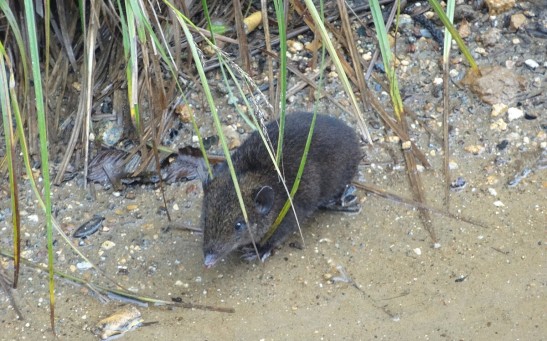If you cannot find the answer you are looking for, please contact us.
Dalat gymnure

Described as a distinct species in December 2023, the Dalat Gymnure is named after the Da Lat Highlands of southern Vietnam and is notable for the striking long upper incisors of mature males, inspiring the Vietnamese name macarong, meaning “vampire.”
Taxonomy
| Kingdom: | Animalia |
| Phylum: | Chordata |
| Class: | Mammalia |
| Order: | Eulipotyphla |
| Family: | Erinaceidae |
| Genus: | Hylomys |
| Species: | Hylomys macarong |
Not a ‘real’ hedgehog
The Dalat Gymnure is part of the same family as hedgehogs (Erinaceidae), but belongs to the subfamily gymnures, also known as hairy hedgehogs, not true spiny hedgehogs. Like true hedgehogs, it is nocturnal, insectivorous, and relies on a keen sense of smell. However, it lacks spines, cannot curl into a protective ball, and instead has coarse fur and a slender body, resembling a shrew more than a hedgehog, though it is a close evolutionary relative.
Natural range & habitat
This species is endemic to the Da Lat and Dak Lak Plateaus in southern Vietnam, at elevations ranging from 30 to 1,750 meters above sea level. It inhabits lowland deciduous forests and mid-elevation evergreen and savanna forest mosaics, often sheltering under grass, tree trunks, shrubs, or near water margins. Its distribution appears highly localized and fragmented.
Physical traits
Medium-sized among gymnures, it measures around 13.5 to 17 cm in total length, including a relatively long tail (~2–2.5 cm, about 17% of body length). Its fur is brown with dark guard hairs and a rust-colored belly in males. Notably, mature males have striking long upper incisors, longer than females, resulting in some sexual dimorphism of the canines.
Behavior & lifestyle
Little is known about its behavior. A juvenile female and an adult male were found in the same trap on consecutive days, suggesting possible parental care or overlapping home ranges. Juveniles have typically been recorded from September to mid‑October, while males show their reddish ventral color between July and September, perhaps linked to breeding seasonality.
Communication
No specific observations exist, but like other gymnures, chemical communication via scent marking, along with subtle body language and perhaps soft vocalization, are likely modes of interaction, especially for reproductive or territorial signals.
Diet in the wild
Dietary habits remain undocumented. However, as an insectivorous mammal, it likely feeds on insects, larvae, earthworms, and other invertebrates. The long incisors of males may assist in capturing or processing certain prey, but further study is needed to clarify dietary specialization.
Reproduction & life cycle
Evidence suggests an extended breeding season: males with rust-colored chests and enlarged testes appear from July to September, and young are found from mid‑September to October. One female with six nipples was noted in December, indicating active lactation.
Threats & conservation status
As a newly described species, the Dalat Gymnure is not yet assessed by the IUCN. Its habitat lies in a region of intense deforestation and land-use change, making it potentially vulnerable. It is known to occur in protected areas such as Bu Gia Map and Cat Tien National Parks, but its true population size and resilience remain unknown.
This species in captivity
There are no known records of the Dalat Gymnure being held in captivity. Its limited distribution, elusive nature, and potential habitat specificity make it an unlikely candidate for ex situ conservation efforts.
